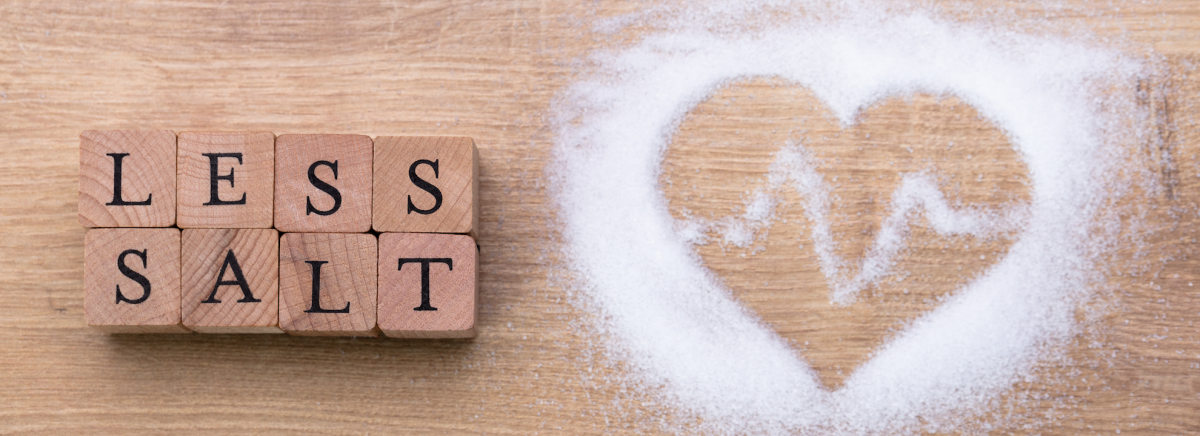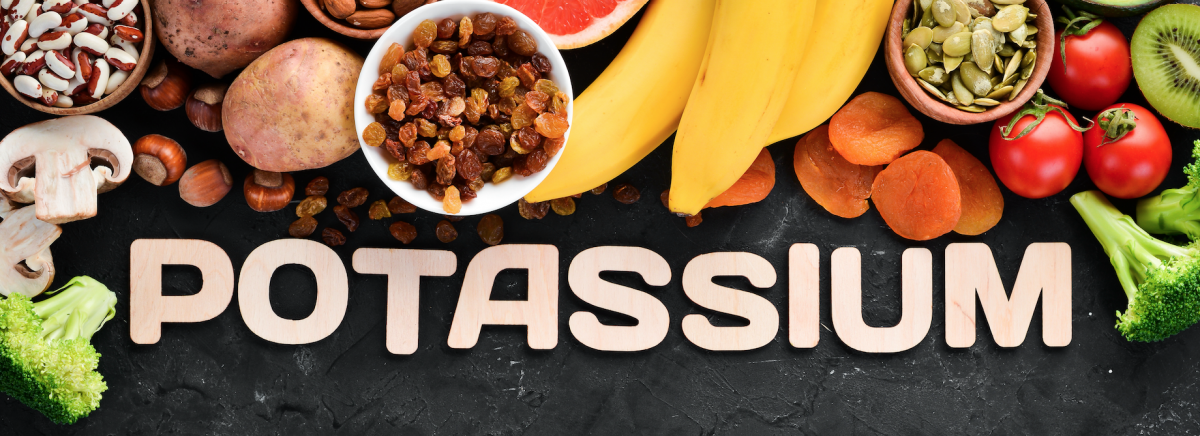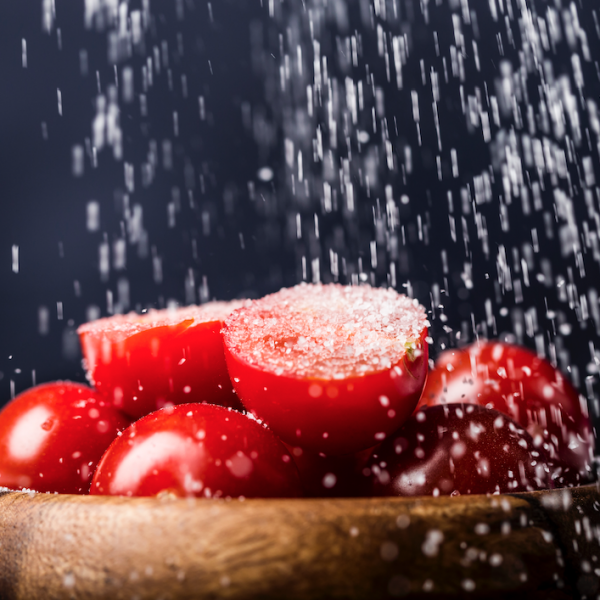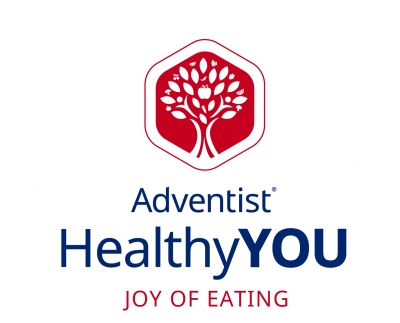The Salt of the Earth: How Much is Safe to Use
Contributed by Maggie Collins, MPH, RDN, CDCES, DipACLM
Health experts agree that most people consume too much sodium, and that it has been linked to some health problems, especially an increased risk for cardiovascular disease. One study concluded that salt (the main source of sodium in our foods) is associated with almost 10% of deaths related to cardiovascular disease worldwide. With that in mind, is there room to safely use salt at all? Are there healthier salt-substitutes? How can our food taste good if we cut back or even eliminate table salt? Can we also develop health problems from consuming too little sodium? We will answer these and other questions related to salt based on the Word of God and current research.
Many health experts agree that we consume too much salt in the US and in many places worldwide, and the excess sodium from this source is an important contributing factor for the development of many chronic diseases. Therefore, reducing salt intake has been encouraged as a public health initiative to achieve Chronic Disease Risk Reduction (CDRR).
On the other hand, based on emerging research, some scientists and health professionals are bringing to light the fact that too little salt can also be detrimental to our health and that an adequate potassium intake can neutralize the negative effects from too much sodium [1].
The Difference between Sodium and Salt
Sodium is an essential nutrient, needed for physiological processes in very small amounts under normal conditions. Some of the roles of sodium in the body include:
- Regulation of extracellular volume
- Acid-base balance
- Nerve impulse transmission
- Muscle contraction
Sodium is naturally occurring in both plants and animal foods, and is found in a concentrated form in salt (sodium chloride). It is estimated that 90% of the sodium we consume is in the form of salt [2]. One teaspoon of salt contains 2,360 mg sodium.
Salt is an ancient substance used in foods mainly to enhance flavor. It is also used as a preservative since, when added to foods in high concentrations, salt creates a hostile environment for certain microorganisms, dehydrates bacterial cells and, therefore, inhibiting bacterial growth and subsequent food spoilage.
Are there any other concentrated sources of Sodium besides salt?
- Sodium containing substances are used in processed meats (such as: ham, hot dogs, bacon, lunch meats, corned beef, sausage, bologna) for preservation and to help obtain a certain color in the product. Examples are:
- Sodium alginate
- Sodium nitrite
- Sodium nitrate
- Sodium benzoate
- Sodium sulfate
- Monosodium glutamate (aka MSG) is a well-known flavor enhancer.
- Baking soda (sodium bicarbonate) and baking powder (which also has sodium bicarbonate as one of its ingredients) are typically used in baking.
How Much Sodium is Recommended per Day
The Adequate intake (AI) of sodium estimated for infants is based on the average intake in healthy infants, as follows[3]:
| Age Group | Adequate Sodium Intake |
|---|---|
| 0 – 6 months | 110 mg/day (estimate from breast milk alone) |
| 7- 12 months | 370 mg/day (estimate from breast milk plus complementary foods) |
For older age groups, the adequate sodium and suggested limit are described below: [3]:
| Age Group | Adequate Sodium Intake | Suggested Sodium Intake Limit |
|---|---|---|
| 1 – 3 years | 800 mg/day | 1,200 mg/day |
| 4 – 8 years | 1,000 mg/day | 1,500 mg/day |
| 9 – 13 years | 1,200 mg/day | 1,800 mg/day |
| 14 year and older | 1,500 mg/day | 2,300 mg/day |
According to the American Heart Association (AHA), the amount of sodium needed for our daily physiological functions is less than 500 mg (equivalent to less than ¼ teaspoon of salt) [4]. The average intake of sodium in this country is estimated to be around 3,400 mg per day [5], which the AHA claims is leading to an increased risk of several chronic diseases related to sodium excess.

What are the health conditions associated with excess sodium intake?
Hypertension (also known as High Blood Pressure)
Defined as a blood pressure at or above 130/80 mmHg, hypertension is linked to the leading cause of death in the United States – namely cardiovascular disease – and is considered the most important preventable risk factor for mortality [6]. The most recent data shows that in 2019 hypertension was either a primary or contributing cause of over half a million deaths in the US [7].
Some people, including older adults, African Americans, and individuals who have metabolic syndrome, diabetes, or chronic kidney disease, are more sensitive to salt in their diet and when eating a diet high in sodium and low in potassium are more prone to develop hypertension [8].
It is important to note, however, that hypertension can also be precipitated by other unhealthy lifestyle habits (such as excessive alcohol or caffeine intake, insufficient physical activity, drug abuse, smoking, and not getting enough good-quality sleep), another medical condition, or certain medications (such as antidepressants; hormonal birth control pills; decongestants; and non-steroidal anti-inflammatory drugs such as aspirin or ibuprofen).[8]
Cardiovascular Disease
Because high sodium intake can increase blood pressure in individuals that are salt-sensitive and high blood pressure is a major risk factor for heart disease and stroke, public health agencies typically generalize the recommendation to lower sodium intake, as lower sodium intake has been associated with a reduced risk of cardiovascular disease and all-cause mortality [2].
Chronic Kidney Disease
A high intake of salt can be damaging to the kidneys in several ways: indirectly as blood pressure rises, by damaging the lining of the arteries that feed the kidney, and by damaging the kidney cells through oxidative stress. There is a dose-dependent increased risk of chronic kidney disease with a high salt diet [2].
Kidney Stones and Osteoporosis
A high-salt intake has been associated with increased calcium excretion as the blood is filtered through the kidneys. This can increase the risk for osteoporosis (since calcium from the bones is mobilized and transferred to the blood to replenish calcium losses) and kidney stones (since calcium is a major component of most types of kidney stones). [2]
Autoimmune Disease
Salt may play a role in the development of autoimmune diseases (such as rheumatoid arthritis, Crohn’s disease, and multiple sclerosis). The proposed mechanism suggests that high sodium intake can shift a type of immune cell that regulates our immune system into an inflammatory type of cell, which can precipitate an autoimmune disease in genetically susceptible individuals [9, 10].
Stomach Cancer
A systematic review published in 2020 lists high salt intake as one of the dietary factors linked to a significant increase of stomach cancer [11]. The studies reported in this review, found the increased risk for stomach cancer in subjects consuming over 5,000 mg of sodium per day from salt (equivalent to a little over two teaspoons of salt). One of the proposed mechanisms is that a high-salt intake cause direct damage to the cells in the lining of the stomach which can precipitate mutations that can lead to cancer [12].
How much salt is safe to use?
The Dietary Guidelines for Americans states that we should limit our sodium intake to 2,300mg/day [13]. This amount represents the sodium in about one teaspoon of salt. However, we need to account for the sodium in processed foods. Unless you are keeping a food diary and methodically keeping track of your sodium intake, it is difficult to accurately estimate the sodium being consumed from homemade foods in combination with processed foods. A more practical approach is to minimize the use of salt at home and when buying processed foods avoid those that are high in sodium by reading the labels and looking at the Daily Value%.
- If the Daily Value for Sodium is 5% or less, that indicates that food is low in sodium.
- If the Daily Value for Sodium is 20% or more, that indicates that food is high in sodium.

Potassium, the balancing mineral
There is evidence that salt sensitivity can be reversed with sufficient amounts of potassium in the diet [6, 14] and that potassium can neutralize the detrimental effects of sodium. The daily recommended potassium intake for adults is 4,700 mg/day [3], however, it is estimated that less than 2% of US adults meet this recommendation[15].
Potassium concentrates more in foods from plant-sources. Examples are:
Potassium Content of Selected Plant-based Foods
| Food | Serving | Potassium Content |
|---|---|---|
| Russet Potato | 1 medium | 952 mg |
| Avocado | 1 medium | 690 mg |
| Pomegranate | 1 medium (~4″ diameter) | 666 mg |
| Beet Greens | ½ cup | 654 mg |
| Pistachios, roasted | ½ cup, shelled | 620 mg |
| Coconut water | 1 cup (8oz) | 600 mg |
| Edamame, dry roasted | 1/3 cup | 530 mg |
| Banana | 1 large (~8″ long) | 487 mg |
| Brussels sprouts | 1 cup, cooked | 450 mg |
| Golden potatoes | 1 medium (~3oz) | 419 mg |
| Portobella mushroom, raw | 1 cup, diced | 313 mg |
| Pulses (all varieties) | ½ cup, cooked | 300 – 350 mg |
| Grape Tomatoes | 1 cup | 395 mg |
| Soy milk, original | 1 cup | 379 mg |
Source: U.S. Department of Agriculture, Agricultural Research Service. FoodData Central, 2019. fdc.nal.usda.gov.
Is consuming too little sodium detrimental to our health too?
A meta-analysis study published in 2014 analyzed the data from 23 cohort studies and 2 follow-up studies. Involving 274,683 participants, the meta-analysis concluded that both low sodium as well as high sodium intakes are associated with increased mortality [16]. The low-sodium category was defined as an average intake of sodium intake less than 2,645 mg/day (equivalent to a little over a teaspoon of salt), whereas the high sodium category was defined as an average intake of sodium greater than 4,945 mg/day (equivalent to a little over two teaspoons of salt).
Another large study analyzed the sodium and potassium intake from 101,945 individuals in 17 countries. Based on the fasting urine excretion of those minerals, the researchers concluded that a sodium intake between 3,000 and 6,000 mg per day was associated with a lower risk of death and cardiovascular events compared to an intake outside this range. This amount of sodium would be equivalent to 1 ¼ – 2 ½ teaspoons of salt per day.
Similar findings pointing to a more moderate intake of salt versus a drastic reduction being associated with reduced mortality have also been found in studies looking at individuals with type 2 diabetes and congestive heart failure [17, 18].
Individuals who had their colon removed and have an ileostomy lose a large amount of fluids and sodium, and need to replenish the salt lost by consuming at least 1 teaspoon of salt per day [19, 20], so a low-salt diet is not indicated in this population. A low-salt diet is also not recommended for individuals who sweat profusely, whether through regular physical activity or by any other reasons (such as being exposed to high temperature or those suffering from conditions that cause excessive sweating such as cystic fibrosis). [3, 21, 22]
What does the Bible say about using Salt in foods?
The Bible is one of the historical references on the use of salt to give flavor to foods in general, including meat offerings (Leviticus 2:13, Ezra 6:9, Job 6:6, Mark 9:49).
“You are the salt of the earth; but if the salt loses its flavor, how shall it be seasoned? It is then good for nothing but to be thrown out and trampled underfoot by men.” Matthew 5:13
“Salt is good, but if the salt loses its flavor, how will you season it? Have salt in yourselves, and have peace with one another.” Mark 9:49
What does the Seventh-Day Adventist Health Message say about Salt?
Based on the inspired writings from Ellen White, we have evidence that salt plays an essential physiological role as well as an important role of enhancing the flavor in the healthy foods we prepare.
“Some of our people, while conscientiously abstaining from eating improper foods, neglect to supply themselves with the elements necessary for the sustenance of the body. Those who take an extreme view of health reform are in danger of preparing tasteless dishes, making them so insipid that they are not satisfying. Food should be prepared in such a way that it will be appetizing as well as nourishing. It should not be robbed of that which the system needs. I use some salt, and always have, because salt, instead of being deleterious, is actually essential for the blood... “{Counsels for the Church 237.3}
The following statement, however, adds balance to our inspired understanding about salt pointing that we should not use large amounts of it:
“Do not eat largely of salt; give up spiced pickles; keep fiery food out of the stomach; eat fruit with the meals, and the irritation that calls for so much drink will cease to exist. But if anything is needed to quench thirst, pure water is all that nature requires. Never take tea, coffee, beer, wine, or any spirituous liquor”. {Christian Temperance and Bible Hygiene 51.3}
Seven Tips to Avoid Excessive Salt Intake
- Eat an abundance of fruits and vegetables (aim for at least ½ the plate being composed of these food groups combined or separate).
- Limit eating out, as we do not have control on the amount of salt being used.
- Read labels and avoid those foods that are high in sodium.
- Do not use a salt shaker at the table. Instead, replace the it with a salt-free seasoning mix.
- Use more herbs and spices when cooking to enhance the flavor.
- Squeeze some lemon or lime on your savory foods as the citric acid in these fruits also gives a salty flavor.
- Replace some of the salt in cooking with miso or soy sauce, as there is scientific evidence that the components in soy can neutralize the negative impact of the sodium present on those foods on blood pressure [23, 24], especially in people who don’t suffer from hypertension yet [25].
Summary
Although we don’t have a consensus on how much salt we should limit to, we do have evidence that too little and too much sodium (which is mainly consumed in the form of salt) can be detrimental to our health. Therefore, it is wise to take the prudent approach of using salt in moderation when cooking, while limiting the consumption of processed food high in sodium.
Scientific evidence also shows that a high salt diet is more harmful if potassium intake is insufficient. Therefore, as important as it is to avoid foods high in sodium it is to guarantee an adequate intake of potassium, which is easier to achieve as we center our diets on foods from plant-sources that are unprocessed or minimally processed.

References
- O’Donnell, M., et al., Joint association of urinary sodium and potassium excretion with cardiovascular events and mortality: prospective cohort study. Bmj, 2019. 364: p. l772.
- He, F.J., et al., Salt Reduction to Prevent Hypertension and Cardiovascular Disease: JACC State-of-the-Art Review. J Am Coll Cardiol, 2020. 75(6): p. 632-647.
- National Academies of Sciences, E., et al., The National Academies Collection: Reports funded by National Institutes of Health, in Dietary Reference Intakes for Sodium and Potassium, M. Oria, M. Harrison, and V.A. Stallings, Editors. 2019, National Academies Press (US). Copyright 2019 by the National Academy of Sciences. All rights reserved.: Washington (DC).
- American Heart Association. How much sodium should I eat per day? Last Reviewed: May 23, 2018; Available from: https://www.heart.org/en/healthy-living/healthy-eating/eat-smart/sodium/how-much-sodium-should-i-eat-per-day.
- U.S. Food and Drug Administration. Sodium in Your Diet. Last Updated on June 08, 2021; Available from: https://www.fda.gov/food/nutrition-education-resources-materials/sodium-your-diet.
- Whelton, P.K., Sodium, potassium, blood pressure, and cardiovascular disease in humans. Curr Hypertens Rep, 2014. 16(8): p. 465.
- Centers for Disease Control and Prevention. Facts About Hypertension. Last reviewed September 27, 2021; Available from: https://www.cdc.gov/bloodpressure/facts.htm.
- National Heart, L., and Blood Institute,. High Blood Pressure. Last updated May 08, 2020; Available from: https://www.nhlbi.nih.gov/health-topics/high-blood-pressure.
- Sharif, K., H. Amital, and Y. Shoenfeld, The role of dietary sodium in autoimmune diseases: The salty truth. Autoimmun Rev, 2018. 17(11): p. 1069-1073.
- Farez, M.F., et al., Sodium intake is associated with increased disease activity in multiple sclerosis. J Neurol Neurosurg Psychiatry, 2015. 86(1): p. 26-31.
- Poorolajal, J., et al., Risk factors for stomach cancer: a systematic review and meta-analysis. Epidemiol Health, 2020. 42: p. e2020004.
- Zhong, C., et al., Sodium intake, salt taste and gastric cancer risk according to Helicobacter pylori infection, smoking, histological type and tumor site in China. Asian Pac J Cancer Prev, 2012. 13(6): p. 2481-4.
- Agriculture., U.S.D.o.H.a.H.S.a.U.S.D.o. 2020 – 2025 Dietary Guidelines for Americans.9th Edition. 2020 December 2020; Available from: www.dietaryguidelines.gov/.
- Morris, R.C., Jr., et al., Relationship and interaction between sodium and potassium. J Am Coll Nutr, 2006. 25(3 Suppl): p. 262s-270s.
- Cogswell, M.E., et al., Sodium and potassium intakes among US adults: NHANES 2003-2008. Am J Clin Nutr, 2012. 96(3): p. 647-57.
- Graudal, N., et al., Compared with usual sodium intake, low- and excessive-sodium diets are associated with increased mortality: a meta-analysis. Am J Hypertens, 2014. 27(9): p. 1129-37.
- Ekinci, E.I., et al., Relationship between urinary sodium excretion over time and mortality in type 2 diabetes. Diabetes Care, 2014. 37(4): p. e62-3.
- O’Donnell, M., et al., Urinary sodium and potassium excretion, mortality, and cardiovascular events. N Engl J Med, 2014. 371(7): p. 612-23.
- Sacher, P., et al., The importance of oral sodium replacement in ileostomy patients. Prog Pediatr Surg, 1989. 24: p. 226-31.
- Hill, G.L., W.S. Mair, and J.C. Goligher, Cause and management of high volume output salt-depleting ileostomy. Br J Surg, 1975. 62(9): p. 720-6.
- Baker, L.B., Sweating Rate and Sweat Sodium Concentration in Athletes: A Review of Methodology and Intra/Interindividual Variability. Sports Med, 2017. 47(Suppl 1): p. 111-128.
- Declercq, D., et al., Sodium Status and Replacement in Children and Adults Living with Cystic Fibrosis: A Narrative Review. J Acad Nutr Diet, 2020. 120(9): p. 1517-1529.
- Ito, K., et al., The Effects of the Habitual Consumption of Miso Soup on the Blood Pressure and Heart Rate of Japanese Adults: A Cross-sectional Study of a Health Examination. Intern Med, 2017. 56(1): p. 23-29.
- Okada, E., A. Saito, and H. Takimoto, Association between the Portion Sizes of Traditional Japanese Seasonings-Soy Sauce and Miso-and Blood Pressure: Cross-Sectional Study Using National Health and Nutrition Survey, 2012⁻2016 Data. Nutrients, 2018. 10(12).
- Nozue, M., et al., Fermented Soy Product Intake Is Inversely Associated with the Development of High Blood Pressure: The Japan Public Health Center-Based Prospective Study. J Nutr, 2017. 147(9): p. 1749-1756.


Leave A Comment